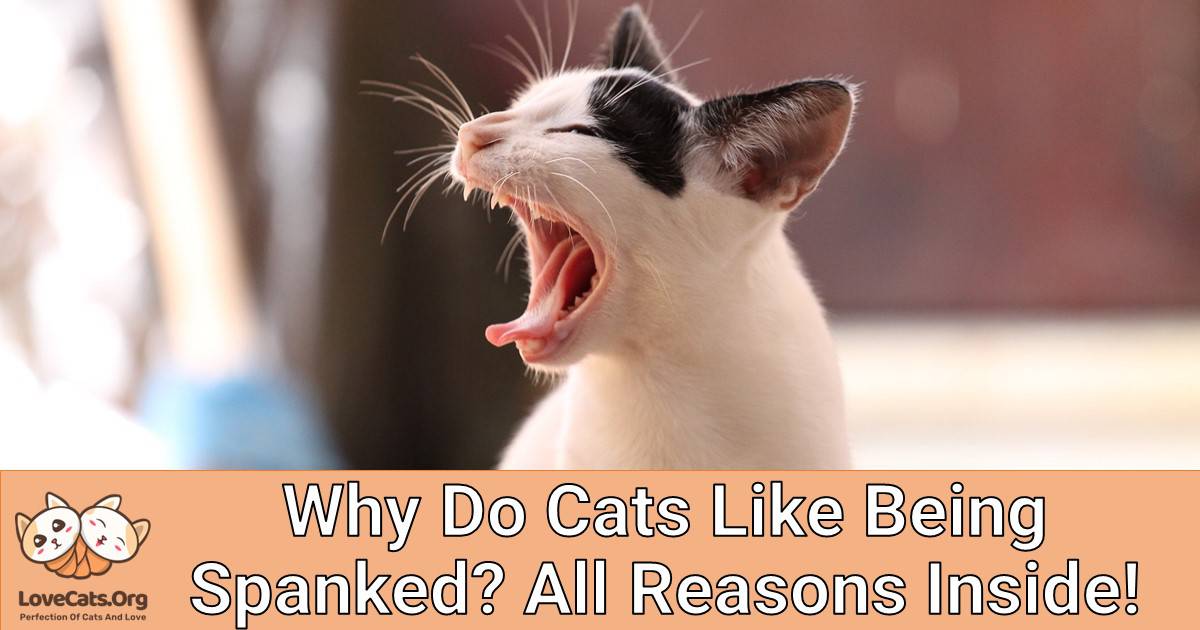Cats love being spanked! It’s a strange phenomenon, but it is true.
Spanking cats can be beneficial for both the cat and its owner in many ways:
- It helps to build trust between them;
- Strengthens their bond;
- Encourages playtime activities that keep your pet active and healthy;
- Provides mental stimulation, which keeps boredom at bay.
Additionally, some experts believe spanking may help reduce cat stress levels by releasing endorphins – hormones associated with pleasure – into their system when touched or stroked during this activity.
As long as you do not hit too hard or cause pain to your feline friend, there should be no harm from occasional light taps on the backside of your furry companion!
Do Cats Like Being Spanked?
Cats do not like being spanked.
It is a form of physical punishment that can cause fear and anxiety in cats. That lead to behavioral issues such as aggression or hiding away from people.
Cats are sensitive creatures who need gentle handling. They don’t respond well to harsh treatment.
Here are some reasons why:
- Spanking causes pain – it’s uncomfortable for any animal, including cats!
- Fearful reactions – when scared by sudden loud noises or aggressive behavior (like spanking), cats may become defensive and lash out with their claws/teeth if feeling threatened enough.
- Stress hormones released into the body could lead to long-term health problems due to prolonged exposure.
- Loss of trust between cat and owner – once your pet has been physically punished, they will be less likely to come near you again because they won’t feel safe anymore.
The best way for owners to show discipline towards their feline friends is through positive reinforcement techniques.
For example, reward systems using treats or toys instead of punishing them harshly with a physical force like spankings which only serves further distress.
How Do Cats Feel When They Are Spanked?
Cats do not like to be spanked.
When they are, cats feel scared and confused.
They may become aggressive or defensive in response to physical punishment.
This is a natural reaction for any animal that feels threatened by an unfamiliar situation.
Cats can also experience feelings of betrayal if their owner has been punishing them with something other than verbal reprimands up until then.
Owners must remember that cats don’t understand why they’re punished when you use physical force against them!
Here are some signs your cat might display after being spanked:
- Hiding away from people/other animals
- Refusing food or water
- Excessive meowing
- Aggression towards humans/animals
- Increased anxiety levels
- Loss of trust in its owner
It’s best practice never to physically punish your pet, as it will only lead to further confusion and distress.
Instead, use positive reinforcement techniques such as treats, toys, and praise.
That has proven more effective at teaching good behavior over time, anyway!
How Should You Spank Your Cat?
You should never spank your cat!
Cats are sensitive creatures, and physical punishment can cause them to become fearful or aggressive.
Instead, use positive reinforcement techniques such as:
- Praise – Give verbal praise when they do something well;
- Treats – Offer treats for desired behaviors;
- Toys and Playtime – Provide toys that encourage exercise and playtime with you.
- This will help build a bond between you while enjoyably teaching appropriate behavior.
- Additionally, make sure their environment is stimulating by providing scratching posts, hiding spots, and other items cats enjoy playing with so they don’t get bored easily, which could lead to unwanted behaviors like clawing furniture or jumping on counters.
Finally, if all else fails, seek professional advice from a veterinarian specializing in animal behavior problems before resorting to any physical discipline!
When Should You Spank Your Cat?
It would help if you never spanked your cat.
Cats are sensitive creatures, and physical punishment can cause them to become fearful or aggressive, which is not good for their mental health.
Instead of using physical discipline, there are other ways you can train a cat:
- Positive reinforcement – reward desired behaviors with treats or praise;
- Redirecting behavior – if the cat does something undesirable (e.g., scratching furniture), distract it by offering an alternative activity, such as playing with toys;
- Time-outs – remove the animal from its current environment when it misbehaves and place it in another area until it calms again;
- Clicker training – use a clicker device to mark desirable behaviors, so cats learn what they’re doing right instead of wrong!
Spanking may seem like an easy solution but ultimately will do more harm than good for you and your pet’s relationship.
When Should You Not Spank Your Cat?
It would help if you never spanked your cat.
It is ineffective to discipline them and can cause more harm than good.
Here are some reasons why you shouldn’t:
- Cats don’t understand physical punishment. It will only make them scared of you, or worse – aggressive!
- Spanking a cat could lead to serious injury if done too hard or in the wrong place (e.g., on the head).
- Hitting cats may also encourage fear-based behaviors such as hiding, cowering, and urinating outside the litter box out of anxiety/fear.
Instead of using physical force when disciplining your pet, try these methods instead:
- Positive reinforcement – reward desired behavior with treats and praise, so they learn what actions get rewarded by humans
- Redirect unwanted behavior onto appropriate toys like scratching posts for clawing furniture.
- Provide plenty of mental stimulation through interactive playtime activities that entertain the kitty.
Do Cats Understand When You Spank Them?
No, cats do not understand when you spank them.
Spanking is a form of physical punishment that can cause animal fear and anxiety.
Cats are sensitive creatures who respond better to positive reinforcement than negative discipline methods like spanking or scolding.
Positive reinforcement includes rewards such as treats, toys, verbal praise, and petting for desired behaviors.
This encourages the cat to repeat those behaviors instead of punishing it with something unpleasant like a swat on the behind!
Here are some tips for training your cat:
- Use food-based rewards – Offer small pieces of their favorite treat after they perform an action correctly (e.g., coming when called).
- Give lots of love and attention – Spend quality time playing together daily, so your kitty knows how much you care about them! This will help build trust between both parties, which makes learning easier too!
- Be consistent – Ensure all family members use similar commands/signals during training sessions. So there’s no confusion from different instructions given at once or over time by multiple people involved in the teaching process.
In conclusion, cats don’t understand what happens if we try to punish them through spanking.
Because it’s ineffective and could even make matters worse by causing more stress rather than helping resolve any behavioral issues in our feline friends’ lives.
How Much And How Often Should You Spank Your Cat?
When it comes to spanking your cat, you should consider a few things.
First and foremost, cats do not respond well to physical punishment; they will become fearful of their owners if hit or punished too harshly.
Therefore, the amount and frequency with which one chooses to spank their cat are very important:
- Spanking should only be used as an absolute last resort when all other methods have failed – such as verbal reprimands or time-outs in another room away from people/other animals.
- The intensity of any swatting must remain light – no more than what would feel like a gentle tap on the nose for humans (e.g., using rolled-up newspaper).
- It’s a best practice that this discipline never exceeds three times per incident. So that it does not cause fear in your pet nor create negative associations between yourself and them over time due to its repetitive nature.
In conclusion, while some may argue against ever physically disciplining cats at all costs, it can still serve as an effective tool under certain circumstances, provided these guidelines are followed closely :
- Use sparingly and lightly.
- Ensure safety by avoiding contact with sensitive areas such as eyes and ears.
- Avoid repetition beyond 3 swats max;
- Always follow up immediately afterward with positive reinforcement, treats/cuddles.
Conclusion: Why Do Cats Like Being Spanked?
Cats like being spanked for a variety of reasons.
It can express affection, as cats enjoy physical contact with their owners and may even seek it out when feeling lonely or neglected.
Spanking also helps stimulate the cat’s senses by providing tactile stimulation similar to grooming behavior in other animals.
Additionally, some cats find pleasure in the sensation itself.
This could explain why many felines purr while receiving gentle taps on their backside!
Ultimately, whether you choose to spank your feline friend or not should depend upon how comfortable both parties feel about it
if done correctly and respectfully, then there shouldn’t be any harm caused either way!


